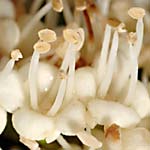|
Viburnum leaf
beetle home
Guide to identifying Viburnums
Common
names
Is
it a viburnum?
Which
viburnum?
Express key
ID
tutorial
Guide to viburnums by David Swaciak.
Leaf drawings by
Marcia Eames-Sheavly.
Logo
images by Paul Weston & Craig Cramer
|
Note: This species combines what were once considered two distinct species, the European cranberry bush (V. opulus) and the American cranberry bush (V. opulus var. americana). Most references still refer to the American cranberry bush by its old latin name, V. trilobum. The two cranberry bushes are difficult to distinguish, and for the purposes of this project, you don't need to tell them apart. Simply choose V. opulus on the data form.
|
Leaves:
- Deciduous
- 2 to 4 inches long and wide
- 3 lobes
- Pubescent (hairy) veins on underside
|
|
Flowers:
- Small white, held in 2- to 3.5-inch flat clusters
- Less showy fertile
inner flowers are surrounded by a ring of showier sterile flowers
- Inner flowers have creamy yellow anthers (pollen
filaments, right)
Fruit:
- Bright red berries held in pendulous (drooping) clusters
|

Click for larger image. |
Petiole:
- Stipules (fang-like appendages) along base of petiole (leaf
stem)
- Glands (bumps) on petiole near base of leaf blade
Cultivar 'Roseum'
Also known as European Snowball bush or Guilder Rose, this old favorite is covered with showy, white, 3-inch-wide inflorescences of sterile flowers, which produce no fruit. Flowers start out greenish and may turn pinkish as they mature.
More information:
|
Similar
Species and distinguishing characteristics:
Back to beginning Which viburnum is it?
© Copyright, Department of Horticulture, Cornell University.
Project coordinator: Lori Brewer, ljb7@cornell.edu
Website design: Craig Cramer cdc25@cornell.edu
Mention of trade names and commercial products is for educational
purposes; no discrimination is intended and no endorsement by Cornell
Cooperative Extension or Cornell University is implied. Pesticide
recommendations are for informational purposes only and manufacturers'
recommendations change. Read the manufacturers' instructions carefully
before use. Cornell Cooperative Extension and Cornell University assumes
no responsibility for the use of any pesticide or chemicals. Some
of the links provided are not maintained by Cornell Cooperative Extension
and Cornell University. Cornell Cooperative Extension and Cornell
University are not responsible for information on these websites.
They are included for information purposes only and no endorsement
by Cornell Cooperative Extension or Cornell University is implied.
Cornell Cooperative Extension provides equal program and employment
opportunities. |